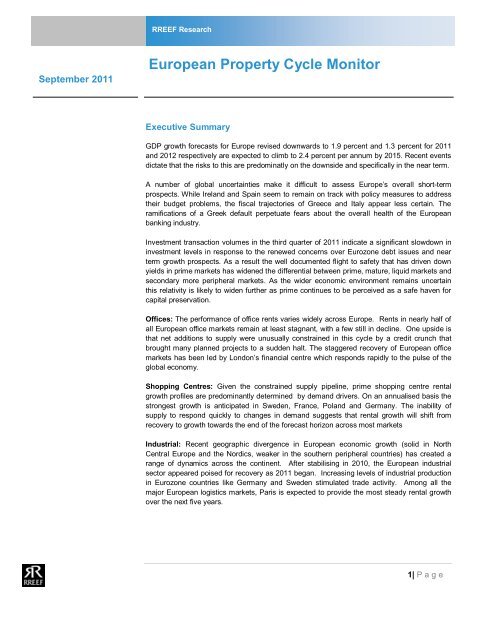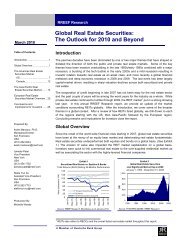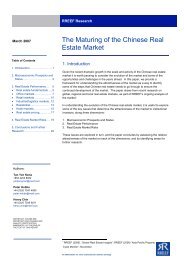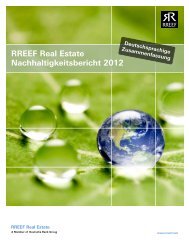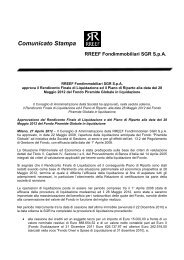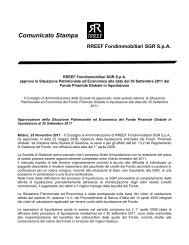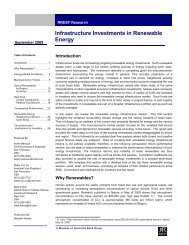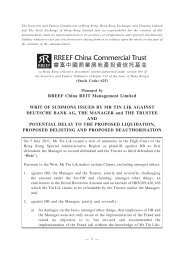European Property Cycle Monitor - RREEF Real Estate
European Property Cycle Monitor - RREEF Real Estate
European Property Cycle Monitor - RREEF Real Estate
Create successful ePaper yourself
Turn your PDF publications into a flip-book with our unique Google optimized e-Paper software.
September 2011<br />
<strong>RREEF</strong> Research<br />
<strong>European</strong> <strong>Property</strong> <strong>Cycle</strong> <strong>Monitor</strong><br />
Executive Summary<br />
GDP growth forecasts for Europe revised downwards to 1.9 percent and 1.3 percent for 2011<br />
and 2012 respectively are expected to climb to 2.4 percent per annum by 2015. Recent events<br />
dictate that the risks to this are predominatly on the downside and specifically in the near term.<br />
A number of global uncertainties make it difficult to assess Europe’s overall short-term<br />
prospects. While Ireland and Spain seem to remain on track with policy measures to address<br />
their budget problems, the fiscal trajectories of Greece and Italy appear less certain. The<br />
ramifications of a Greek default perpetuate fears about the overall health of the <strong>European</strong><br />
banking industry.<br />
Investment transaction volumes in the third quarter of 2011 indicate a significant slowdown in<br />
investment levels in response to the renewed concerns over Eurozone debt issues and near<br />
term growth prospects. As a result the well documented flight to safety that has driven down<br />
yields in prime markets has widened the differential between prime, mature, liquid markets and<br />
secondary more peripheral markets. As the wider economic environment remains uncertain<br />
this relativity is likely to widen further as prime continues to be perceived as a safe haven for<br />
capital preservation.<br />
Offices: The performance of office rents varies widely across Europe. Rents in nearly half of<br />
all <strong>European</strong> office markets remain at least stagnant, with a few still in decline. One upside is<br />
that net additions to supply were unusually constrained in this cycle by a credit crunch that<br />
brought many planned projects to a sudden halt. The staggered recovery of <strong>European</strong> office<br />
markets has been led by London’s financial centre which responds rapidly to the pulse of the<br />
global economy.<br />
Shopping Centres: Given the constrained supply pipeline, prime shopping centre rental<br />
growth profiles are predominantly determined by demand drivers. On an annualised basis the<br />
strongest growth is anticipated in Sweden, France, Poland and Germany. The inability of<br />
supply to respond quickly to changes in demand suggests that rental growth will shift from<br />
recovery to growth towards the end of the forecast horizon across most markets<br />
Industrial: Recent geographic divergence in <strong>European</strong> economic growth (solid in North<br />
Central Europe and the Nordics, weaker in the southern peripheral countries) has created a<br />
range of dynamics across the continent. After stabilising in 2010, the <strong>European</strong> industrial<br />
sector appeared poised for recovery as 2011 began. Increasing levels of industrial production<br />
in Eurozone countries like Germany and Sweden stimulated trade activity. Among all the<br />
major <strong>European</strong> logistics markets, Paris is expected to provide the most steady rental growth<br />
over the next five years.<br />
1| Page
<strong>RREEF</strong> Research<br />
April 2011 Table of Contents:<br />
Prepared by:<br />
Simon Durkin<br />
Director<br />
Head of <strong>European</strong> Research<br />
simon.durkin@rreef.com<br />
Jaroslaw Morawski<br />
Vice President<br />
<strong>European</strong> Research<br />
jaroslaw.morawski@rreef.com<br />
Henry Stratton<br />
Assistant Vice President<br />
<strong>European</strong> Research<br />
henry.stratton@rreef.com<br />
Maren Vaeth<br />
Vice President<br />
<strong>European</strong> Research<br />
maren.vaeth@rreef.com<br />
1. Economic Context ................................................................. 3<br />
2. <strong>European</strong> Investment...............................................................6<br />
3. Office Market .......................................................................... 9<br />
4. Shopping Centre Market ..................................................... 12<br />
5. Industrial Market .................................................................. 16<br />
Page<br />
2| Page
<strong>RREEF</strong> Research<br />
1. Economic Context<br />
As 2011 began, a cautiously upbeat outlook prevailed for Europe as well as the broader global<br />
economy. Germany’s vibrant, ongoing economic recovery appeared to be powering <strong>European</strong><br />
growth forward, overshadowing any potential trouble spots in the <strong>European</strong> periphery. While<br />
most economists anticipated that Europe’s overall economic growth would encounter a mild<br />
deceleration period in mid-2011, few expected a significant slowdown. The guarded optimism<br />
began to unravel by the second quarter, however, as worries about the adequacy of Greece’s<br />
2010 fiscal bailout percolated and finally began to spread outward to Portugal, Italy, and even<br />
France. Financial markets became increasingly impatient with <strong>European</strong> policymakers to<br />
resolve the crisis. As ratings agencies began downgrading sovereign debt 1 (most recently Italy<br />
in mid September), an atmosphere of anxiety took hold.<br />
Forecasters began incrementally downgrading their outlooks for economic growth throughout<br />
the summer of 2011. Global Insight’s March forecast originally called for 2.0 percent growth in<br />
Europe as a whole during 2011 and 2012 followed by a gradual acceleration to 2.4 percent by<br />
2015. The near-term, however, feels less steady and forecasts for 2011 and 2012 have now<br />
been scaled back to 1.9 percent and 1.3 percent, respectively (see Exhibit 1).<br />
%<br />
4.0<br />
3.0<br />
2.0<br />
1.0<br />
0.0<br />
-1.0<br />
-2.0<br />
-3.0<br />
-4.0<br />
-5.0<br />
Exhibit 1<br />
<strong>Real</strong> GDP Growth for Europe, 2004-2015f<br />
Global Insight September 2011 Global Insight March 2011<br />
2004 2005 2006 2007 2008 2009 2010 2011f 2012f 2013f 2014f 2015f<br />
Source: Global Insight, f indicates forecast March and September 2011<br />
As the German economy slows, Sweden is likely to be the top performing major economy in<br />
Western Europe in the near term, with 3.1 percent growth forecast in 2011 and 2012 (see<br />
Exhibit 2).<br />
1 “Darkening Clouds: Irish Debt Downgraded as Euro Worries Spread,” Der Spiegel, 13 July 2011.<br />
3| Page
<strong>RREEF</strong> Research<br />
Domestic, as well as external, demand has driven Sweden’s recent economic expansion, and<br />
at least part of this can be pinned to a booming Swedish housing market. 2 With the US and<br />
Europe - Sweden’s key export markets now facing slower growth, however, Sweden’s vibrant<br />
economy is likely to lose some momentum. Near-term currency appreciation could compound<br />
these challenges even more for Sweden’s exporters. After 2013, however, Sweden’s average<br />
growth is likely to ease back in line with other Nordic countries, namely Finland and Norway,<br />
which are expected to see average GDP growth of 2.8 percent and 2.4 percent, respectively,<br />
in the 2013 to 2015 period.<br />
With near-flat growth in the second quarter of 2011, the UK entered the latter half of the year<br />
with tight credit conditions, elevated inflationary levels (relative to the rest of Europe), and<br />
lagging indicators from the business and household sectors. 3 Yet some of these drags on the<br />
economy are starting to ease, with less of a concern now over inflationary pressures. Solid,<br />
back-loaded recoveries in the UK and also Ireland should also propel GDP growth into a<br />
similar range to the Nordics over the next five years. Global Insight forecasts 2.5 percent<br />
average economic growth in the UK by 2013 to 2015 and 2.7 percent in Ireland.<br />
Two of Europe’s more troubled economies – Greece and Portugal – must still contend with<br />
contracting economies in the near-term, but forecasts suggest that fiscal restructuring will<br />
eventually pave the way for stronger growth by 2015. Central and Eastern <strong>European</strong> (CEE)<br />
countries should experience faster growth than their Western <strong>European</strong> counterparts over the<br />
next five years. Annual growth in the Czech Republic, Poland, and even Hungary should<br />
average close to 4 percent between 2013 and 2015.<br />
Greece<br />
Portugal<br />
Italy<br />
Spain<br />
Ireland<br />
Denmark<br />
United Kingdom<br />
Netherlands<br />
France<br />
Norway<br />
Belgium<br />
Germany<br />
Austria<br />
Finland<br />
Sweden<br />
Hungary<br />
Czech Republic<br />
Poland<br />
Exhibit 2<br />
Average Annual <strong>Real</strong> GDP Growth (%)<br />
Near term prospects (2011-2012f) vs. longer term (2013-2015f)<br />
2011f-2012f 2013f-2015f<br />
-4.0 -2.0 0.0 2.0 4.0 6.0 8.0<br />
Average Annual Growth<br />
Source: Global Insight, f indicates forecast September 2011<br />
A number of global uncertainties make it difficult to assess Europe’s overall short-term<br />
prospects. While Ireland and Spain seem to remain on track with policy measures to address<br />
their budget problems, the fiscal trajectories of Greece and Italy appear less certain.<br />
2 <strong>European</strong> Central Bank, Monthly Bulletin, 15 September 2011, pp. 12-13.<br />
3 <strong>European</strong> Central Bank, Monthly Bulletin, 15 September 2011, p. 12.<br />
PIIGS<br />
Core-Europe<br />
CEE<br />
4| Page
<strong>RREEF</strong> Research<br />
The ramifications of a Greek default perpetuate fears about the overall health of the <strong>European</strong><br />
banking industry.<br />
These fears are affirmed by Exhibit 3 which illustrates the LIBOR/OIS spread (overnight index<br />
swap), and reflects the risk premiums banks place on lending to one another. Despite all of the<br />
anxiety over the last couple of weeks, the US credit market appears to be in reasonably good<br />
shape with both corporate and household balance sheets looking relatively healthy.<br />
Furthermore, it would seem that the repairs to the banking and financial system in the US have<br />
improved confidence amongst the banks. In Europe, however, the LIBOR/OIS spread<br />
suggests banks in Europe have less confidence in one another and, as a result, are<br />
demanding higher premiums for short term lending. This is an indicator that should be<br />
monitored carefully as the political and financial situation in Europe evolves.<br />
%<br />
4<br />
3.5<br />
3<br />
2.5<br />
2<br />
1.5<br />
1<br />
0.5<br />
Exhibit 3<br />
USD vs. EUR LIBOR OIS Spread<br />
USD LIBOR - OIS Spread EUR LIBOR - OIS Spread<br />
Market distress stemming from the U.S. financial crisis.<br />
Market distress due to<br />
<strong>European</strong> debt crisis.<br />
0<br />
05-2008 09-2008 01-2009 05-2009 09-2009 01-2010 05-2010 09-2010 01-2011 05-2011 09-2011<br />
Source: Bloomberg 12 September 2011<br />
Recent indicators, however, are suggesting further weakness in the US economy, particularly<br />
with unemployment rates remaining elevated. The announcement of Operation Twist by the<br />
Federal Reserve on September 21 was received by the markets with some scepticism.<br />
Furthermore a continued slowdown in emerging markets, specifically China. suggests that it is<br />
less certain that China and the US will significantly support the <strong>European</strong> and global recovery<br />
in the near-term.<br />
Finally, inflationary pressures appear to have eased as Europe’s economy has slowed,<br />
prompting the <strong>European</strong> Central Bank (ECB) to hold back on further interest rate hikes.<br />
Another rate increase in 2011 appears increasingly less likely, and a softening of ECB policy is<br />
even possible if economic conditions deteriorate further. Within the current economic context,<br />
investors have sought safety, thus pushing German bonds rates to record low levels. Interest<br />
rates, therefore, should stay low in the near term, but over the longer term, rising interest rates<br />
seem more likely.<br />
5| Page
<strong>RREEF</strong> Research<br />
2. <strong>European</strong> Investment<br />
The real estate investment market continued on its recovery path in the first half of 2011 with<br />
transaction activity increasing over the same period in 2010. Total <strong>European</strong> Investment<br />
volumes in this period were 30 percent higher than the corresponding period in 2010 4 . The<br />
retail and office sectors have seen 40 percent and 32 percent growth in transaction volumes<br />
with industrial dropping by 7 percent. However, data for the third quarter of 2011 to date, whilst<br />
still incomplete, indicate a significant slowdown in investment levels in response to the<br />
renewed concerns over Eurozone debt issues and near term growth prospects discussed in<br />
the previous section.<br />
Exhibit 4<br />
<strong>European</strong> Investment Volumes<br />
Source: <strong>European</strong> House Forecasts August 2011<br />
Investor focus remains on well established core <strong>European</strong> markets like Germany, Sweden,<br />
France and the UK, with London and Paris remaining the most active markets. Continued<br />
appetite for prime assets is supported by long term investors looking for secure income from<br />
high quality assets with strong covenants. North American investors accounted for more than<br />
25 percent of the cross border investment in Europe in the first half of 2011 followed by<br />
German and UK buyers. 5 The UK remained a major destination for capital accounting for more<br />
than a third of <strong>European</strong> transactions during this period 6 .<br />
This flight to safety has contributed to further downward pressure on prime cap rates.<br />
Compression has been strongest in Europe’s largest, core liquid markets of France and<br />
Germany, as well as the growth markets of CEE and Sweden. In some markets, prime cap<br />
4 RCA, September 2011<br />
5 CBRE, MarketView Q2 2011<br />
By Region By Sector<br />
€bn €bn<br />
6 DTZ, Investment Market Update Q2 2011<br />
6| Page
<strong>RREEF</strong> Research<br />
rates are approaching levels seen in the previous market cycle. However, non-prime yields<br />
remained elevated and non-prime values remain depressed. Exhibit 5 below shows the relative<br />
recovery in capital values in CBD locations versus the periphery and the widening pricing<br />
differentials between the global cities of Paris and London versus peripheral cities in the UK<br />
and France. As the wider economic environment remains uncertain, this relativity is likely to<br />
widen further as prime continues to be perceived as a safe haven for capital preservation.<br />
%<br />
<strong>European</strong> Office Capital Values Change<br />
Exhibit 5<br />
Office Yields in Primary vs. Secondary Markets<br />
Note: Estimates on the basis of the current prime rent and prime yield.<br />
Source: CBRE August 2011<br />
In our medium term outlook, we would expect the scale and timing of yield and capital pricing<br />
movements to vary significantly from market to market, assuming the relatively uniform and<br />
widespread effects of the financial crisis eventually recede and local economic, demographic<br />
and property market factors become the primary drivers of pricing, especially in supply<br />
constrained markets. However, global capital flows, which will inevitably continue their<br />
increasing importance across Europe, may lead to a more uniform set of adjustments than<br />
would otherwise appear rational. A decompression of yields is still expected in the medium<br />
term as shown in the exhibit below. However, the risks to this gradual profile are very much on<br />
the downside where the risk premium component to our yield forecast will become increasingly<br />
sensitive to ongoing market uncertainty, compounded by a less positive outlook for rental<br />
growth and fundamentals, despite an underlying environment of low interest rates. Increased<br />
uncertainty could also result in a further widening of the spread between prime and secondary<br />
products. While investors’ preference for security could lead to an increased pricing pressure<br />
for the best properties in the most stable markets, lack of demand would likely have the<br />
opposite effect on the less-prime assets.<br />
%<br />
7| Page
<strong>RREEF</strong> Research<br />
%<br />
Exhibit 6<br />
<strong>European</strong> Average Office Cap Rates 2004-2015f<br />
Note: <strong>European</strong> Average weighted by stock, f indicates forecast<br />
Source: <strong>RREEF</strong> Research, PMA August 2011<br />
8| Page
<strong>RREEF</strong> Research<br />
3. Office Market<br />
<strong>European</strong> office rents fell 10 percent in the recent cyclical downturn, but weighted averages<br />
can mask significant variations in performance across geographies. Rents in nearly half of all<br />
<strong>European</strong> office markets remain at least stagnant, with a few still in decline. By 2013, almost<br />
all <strong>European</strong> office markets should have moved past their cyclical troughs, and by 2015, the<br />
majority of markets should have recovered most of the rent levels lost since the last cyclical<br />
peak (see Exhibit 7).<br />
Index Level<br />
120<br />
110<br />
100<br />
90<br />
80<br />
70<br />
60<br />
50<br />
Dublin<br />
Last peak = 100<br />
Exhibit 7<br />
Office Rent Levels at Different Points of the <strong>Cycle</strong><br />
Last Peak to Expected Trough Expected Trough to 2015<br />
London: West End<br />
Madrid<br />
London: City<br />
Barcelona<br />
Birmingham<br />
Lisbon<br />
London: M25 West<br />
Paris: CBD<br />
Warsaw<br />
Stockholm<br />
Milan<br />
Rome<br />
Paris: La Défense<br />
Copenhagen<br />
Edinburgh<br />
Munich<br />
Berlin<br />
Glasgow<br />
Frankfurt<br />
Hamburg<br />
Budapest<br />
Manchester<br />
Dusseldorf<br />
Lyon<br />
Brussels<br />
Prague<br />
Helsinki<br />
Vienna<br />
Amsterdam<br />
Marseille<br />
Lille<br />
Source: <strong>RREEF</strong> Research August 2011<br />
One upside for the <strong>European</strong> office market is lack of supply. Net additions over the past cycle<br />
never reached levels as high as in previous cyclical peaks. New construction, which always<br />
tightens during a cyclical downturn, was even more constrained this time as the credit crunch<br />
brought many planned projects to a sudden halt. All of these factors have resulted in net<br />
additions to office supply being squeezed to their lowest levels of the past two decades (see<br />
Exhibit 8). The supply pipeline is unlikely to resume quickly. By 2015, annual net additions are<br />
expected to be scarcely above three million square metres, or about the same as the cyclical<br />
trough levels of the mid-1990s and mid-2000s.<br />
120<br />
110<br />
100<br />
90<br />
80<br />
70<br />
60<br />
50<br />
9| Page
<strong>RREEF</strong> Research<br />
millions sqm<br />
8<br />
7<br />
6<br />
5<br />
4<br />
3<br />
2<br />
1<br />
0<br />
90<br />
91<br />
92<br />
93<br />
94<br />
95<br />
Exhibit 8<br />
Net Additions of Office Space in Europe<br />
Source: <strong>RREEF</strong> Research, PMA Spring 2011 Forecast<br />
Note: Weighted average of the key markets. f indicates forecast August 2011<br />
London has lead the staggered recovery of <strong>European</strong> office market. While the UK’s national<br />
economic recovery has been mild, London’s financial centre remains closely aligned to the<br />
health of the global economy and this has a direct impact on the local office market. London’s<br />
office demand recovered well in late 2009 and 2010 as a result of pent up requirements<br />
delayed during the financial crisis. Even as muted employment growth limits the potential for<br />
positive net absorption, market churn in London’s City should boost the prospects for high<br />
quality prime space at the expense of older properties, although this demand will remain<br />
contingent on stability of global financial markets. The disruption of supply as a result of the<br />
credit crunch has now begun to impact the market as the availability of high quality stock<br />
depletes in the near term. With the development pipeline now inevitably picking up again,<br />
rental growth should begin levelling off towards the second half of the forecast period. Nearby<br />
in London’s West End, new supply remains constrained, and demand prospects for Grade A<br />
space is supported by a more diverse occupier market that extends beyond the financial sector<br />
to include broad-based services firms. Weaker than expected tenant demand remains a key<br />
risk across London as there is significant precedent for global financial instability to disrupt the<br />
occupier market.<br />
The Paris office market was quick to follow London’s recovery. France’s economy turned in<br />
mid-2009, and office employment growth followed in 2010, along with an upturn in rental<br />
growth in Paris CBD and La Défense. Paris CBD is an international and liquid market that<br />
benefits from broad-based tenant demand and restricted supply. Recent stock additions in La<br />
Défense have made its fundamentals relatively less favourable than the CBD. Forecasts for<br />
office-using employment growth show that the overall Paris market could pick up as many as<br />
60,000 new jobs over the next five years, or about the same number as the combined growth<br />
of French regional cities Lyon, Marseilles, and Lille during the same period. 7 Although the<br />
office cycle in Paris is shaping up to be steadier and less volatile than London’s, it is not<br />
without general downside risks. Rental growth slowed in 2011, with office demand in Paris<br />
likely to be impacted by French austerity programmes as well as wavering business sentiment<br />
and hesitant demand conditions that emerged in mid-2011. As economic conditions stabilise,<br />
office rents in Paris are expected to rebuild their momentum over the next five years.<br />
7 PMA, Spring Forecast 2011.<br />
96<br />
97<br />
98<br />
99<br />
00<br />
01<br />
02<br />
03<br />
04<br />
05<br />
06<br />
07<br />
08<br />
Net additions<br />
… in % of stock<br />
09<br />
10<br />
11F<br />
12F<br />
13F<br />
14F<br />
15F<br />
%<br />
4.5<br />
4.0<br />
3.5<br />
3.0<br />
2.5<br />
2.0<br />
1.5<br />
1.0<br />
0.5<br />
0.0<br />
10| Page
<strong>RREEF</strong> Research<br />
Office markets tend to be relatively less volatile in Germany than in much of the rest of Europe.<br />
The recent cycle has been no exception. Germany’s strong economic fundamentals in 2010<br />
and early 2011 fuelled tenant demand during this period and kept vacancy under control amid<br />
muted supply. While these fundamentals have led to an earlier rental recovery in German<br />
markets than in most of Europe, they have still not produced frothy market conditions. Rents<br />
should grow at a moderate pace of 2.0 to 2.5 percent per annum through 2015. This pace<br />
could even be a bit stronger in Berlin as it shakes off a decade of tepid underperformance.<br />
After years of limited construction and flat rents, the Berlin market this time seems poised for<br />
renaissance. Frankfurt is the market most likely to be Germany’s laggard. The city’s office<br />
demand is plagued by uncertainty about a second wave of saving plans in the banking<br />
industry as well as concern about the general health and stability of the <strong>European</strong> financial<br />
markets. The performance of the Munich and Hamburg office markets will fall somewhere in<br />
the middle between Berlin and Frankfurt. The early and relatively strong growth of office rents<br />
in Munich and Hamburg should taper in the latter years of the forecast.<br />
Even as Europe struggles with sovereign debt issues, the Nordic economies continue to<br />
demonstrate resilience. Sweden’s economic stability through the recent recession and strong<br />
recovery in 2010 and 2011 has led to tightening property fundamentals across Stockholm. This<br />
has resulted in a modest rise in office rents. The market’s front-loaded recovery is likely to be<br />
muted in comparison to previous cycles, with better prospects for the Stockholm CBD and<br />
Inner City than for other sub-markets. Office recoveries in Helsinki and Copenhagen are likely<br />
to be more back-loaded as the supply overhang continues to be absorbed.<br />
Given the fundamental distress, Southern <strong>European</strong> markets, as well as Ireland, are likely to<br />
see a backloaded recovery. Office rents in these markets are still seeking their trough levels<br />
but are set to turn in 2013 or 2014. Prime locations in Iberian markets have stabilised during<br />
2011, but in peripheral locations, rents still face downward pressure. The excessive rental<br />
declines in this cycle are likely to experience strong reversal as the markets begin to turn,<br />
especially in Madrid and Dublin. Barcelona and the Italian markets, particularly Milan and<br />
Rome, should see a more moderate recovery with growth rates of 3 percent to 4 percent in the<br />
outer years of the forecasting period. The laggard in this group is Lisbon, where economic<br />
conditions are generally weaker and hence a later and slower recovery is expected.<br />
The major office markets of the CEE region - Warsaw, Prague, and Budapest - are<br />
experiencing unsynchronised cyclical dynamics. Warsaw is poised for a powerful front-loaded<br />
recovery. Solid economic conditions, a low vacancy rate, and limited supply provide the basis<br />
for 5.0 to 6.0 percent per annum rental growth in 2011 and 2012, followed by a sharp<br />
deceleration in rental gains by 2015. Prague’s cyclical timing is similar to Warsaw but the<br />
shape of Prague’s office cycle will likely be flatter, with 2.0 to 3.0 percent per annum rental<br />
growth in 2011 and 2012, tapering only modestly in the following years. The Budapest office<br />
market still grapples with a surplus of office supply, and the Hungarian economic outlook -<br />
solid by Western <strong>European</strong> standards - still lags the performance of its CEE neighbours in the<br />
near-term.<br />
This pushes back prospects for the Budapest office market’s recovery until 2013 to 2015 when<br />
rental growth could average up to 4.0 percent per annum.<br />
11| Page
<strong>RREEF</strong> Research<br />
4. Shopping Centre Market<br />
In the most indebted markets three factors are simultaneously reducing consumption. Firstly,<br />
declining disposable incomes in real terms as wages freeze while the cost of living inflates.<br />
Secondly, structural reform is reducing spending and/or employment in the public sector,<br />
decreasing demand directly and indirectly. Thirdly, private households are increasing savings<br />
to reduce debt, while the availability of consumer credit has reduced sharply.<br />
In less indebted markets, economies recovered earlier and more sharply, supporting<br />
employment growth and wages. Even where public spending cuts are required, they are less<br />
austere, resulting in a more solvent and confident consumer. However, economic growth<br />
prospects in even the strongest markets are hampered by weak demand for exports elsewhere<br />
in Europe. This is exacerbated by the fact that many of the weakest markets have traditionally<br />
been Europe’s largest and most consumerist economies, including the UK and Spain, as well<br />
as Portugal, Ireland and Greece.<br />
Against this background it is perhaps unsurprising that real retail sales growth for Western<br />
Europe is expected to remain in negative territory at the end of 2011, at negative 0.8 percent. 8<br />
While it is expected to recover in 2012, strengthening over the forecast horizon until the end of<br />
2015, it will remain low relative to its long-term historical performance. Of course, underlying<br />
the aggregate is considerable diversity in both the timing and magnitude of retail sales growth<br />
across markets (Exhibit 9). To some extent this mirrors the timing of economic recovery and<br />
growth, but it also reflects the prevailing consumption culture of markets. For example, the<br />
sustained recovery in Germany in the first half of 2011 revived retail sales which saw German<br />
retail sales move above the <strong>European</strong> average for the first time this century. Yet, relative to<br />
Europe’s aggregate historical performance, at 2.3 percent for the first half of 2011, 9 the<br />
magnitude of retail sales growth in Germany remains modest. Moreover, consumer confidence<br />
is fragile and the impact of the austerity package and environmental taxes to be implemented<br />
in the medium term have been long expected to erode growth by 2013. The more recent<br />
stalling of the German economy, coupled with the renewed turbulence in financial markets as<br />
the soveriegn debt crisis lingers, may cut short the revival in retail sales.<br />
8 Global Insight, September 2011<br />
9 PMA, August 2011<br />
12| Page
<strong>RREEF</strong> Research<br />
Poland<br />
Czech Rep<br />
UK<br />
Hungary<br />
Sweden<br />
France<br />
Ireland<br />
Finland<br />
Germany<br />
Netherlands<br />
Austria<br />
Belgium<br />
Denmark<br />
Spain<br />
Italy<br />
Greece<br />
Portugal<br />
Exhibit 9<br />
Retail sales growth (real) across Europe<br />
2011f 2012f 2013f<br />
-20 -15 -10 -5 0 5 10 15 20<br />
Source: Global Insight. f indicates forecast September 2011<br />
In contrast, the sustained recovery in the highly consumerist economies of Sweden and CEE<br />
has translated into stronger growth. This is anticipated to endure throughout the forecast<br />
horizon. Mirroring the interaction of consumer culture with economic buying power,<br />
consumption growth in France is stronger than what might otherwise be expected. This reflects<br />
the relative un-indebtedness of households cushioning the impact of necessary fiscal cuts on<br />
spending. While off a low base, the late recovery of the consumerist peripheral markets is<br />
expected to generate strong retail sales growth by 2014 or 2015. Indeed, the anticipated<br />
bounce in Spain’s consumption at the back end of the period outweighs the steady, modest<br />
growth of Germany on an annualised basis.<br />
However, the drivers of retailer demand are more complex than simply following trends in retail<br />
sales growth. Retailers have exercised much greater caution, but have continued to pursue a<br />
more limited and uncompromising store expansion programme. Discount retailers have<br />
pursued the most aggressive expansion of stores since the downturn, taking the opportunity to<br />
benefit from an increased market share as well as the greater availability of good quality space<br />
in prime locations, at a lower cost. A number of US operators have expanded their <strong>European</strong><br />
presence since the downturn, focusing on flagship stores and super prime locations in<br />
Europe’s principle retail locations.<br />
Retailers with large, existing portfolios have focused on optimising store portfolios. This<br />
includes rationalising space into a smaller number of larger, better located stores as well as<br />
the closure of non performing stores. Such retailers are taking the opportunity to trade up<br />
portfolios, acquiring space in the best performing centres and High Streets at a lower marginal<br />
cost. This portfolio strategy is resulting in an even greater bifurcation of prime and secondary<br />
locations. This is evident in vacancy rate levels and in rental profiles, with prime rents<br />
stabilised while secondary centre rents decline further.<br />
%<br />
13| Page
<strong>RREEF</strong> Research<br />
While retailers have pursued this portfolio optimisation across all markets, expansion has been<br />
prioritised in early recovery markets such as Sweden, Germany and CEE countries. Of these,<br />
Germany and Poland have benefited from the strongest demand. In Germany, although retail<br />
sales are low per cap and growth is marginal, this remains one of Europe's largest and most<br />
affluent markets. The strong growth in Poland, combined with the scale of its population, make<br />
it a natural focus for retailers seeking a presence in the region. This has assisted in reducing<br />
the impact of a number of highly leveraged national retail chains during the downturn.<br />
The supply pipeline remains very constrained and is continuing to contract as further schemes<br />
in planning or under construction are withdrawn or postponed. This reflects the dearth of<br />
available finance capital and high pre-leasing thresholds required to attain the funding which is<br />
available. A large proportion of new development activity is focused on the largest, most stable<br />
core markets, for example, France and Germany as well as the stronger growth markets,<br />
including Sweden and CEE countries, notably Poland. The market dynamics of lower<br />
availability of finance and more constrained retailer demand means that new activity is<br />
primarily focused on the expansion and refurbishment of existing schemes rather than<br />
brownfield development.<br />
Given the long lead in times for shopping centre development, the ability of supply to respond<br />
to changes in demand is weak. As a consequence, a significant amount of space continues to<br />
be delivered in the Spanish market with 400,000 square metres expected in 2011, mainly in<br />
large schemes. Changes in stock per capita are strongest in Poland and Finland. In the former,<br />
stronger retail sales growth assists in supporting retail sales per square metre, but the scale of<br />
development in second and third tier cities and towns is resulting in an oversupply of space in<br />
regional markets. Although declining in all other markets, forecast national retail sales per<br />
square metre actually increases over the period in the UK, reflecting an absence of new<br />
supply. However, the UK is also experiencing strong sales leakage on-line and to non-food<br />
supermarket retail, reducing sales captured in traditional retail locations.<br />
Given a more constrained supply pipeline, prime shopping centre rental growth profiles are<br />
predominantly determined by demand drivers. On an annualised basis the strongest growth is<br />
anticipated in Sweden, France, Poland and Germany (Exhibit 10). The inability of supply to<br />
respond quickly to changes in demand suggests that rental growth will shift from recovery to<br />
growth towards the end of the forecast horizon across most markets. With a long lead time<br />
from inception to completion, improving fundamentals are likely to accelerate into the next<br />
cycle, with a limited risk of erosion from new supply. The bounce in retail sales growth coupled<br />
with the rental decline experienced in the consumerist economies of the UK, Spain, Ireland<br />
and Portugal point towards a rental rebound from 2014.<br />
14| Page
<strong>RREEF</strong> Research<br />
Exhibit 10<br />
Annualised Prime Shopping Centre Rental Growth 2011-2015f<br />
Source: Global Insight. f indicates forecast September 2011<br />
15| Page
<strong>RREEF</strong> Research<br />
5. Industrial Market<br />
<strong>European</strong> industrial construction remains limited in 2011 with speculative schemes yet to<br />
significantly materialise. Despite a disciplined supply pipeline, industrial rents look set for a<br />
modest cycle since near-term demand conditions remain weak across many markets. In<br />
Europe as a whole, market fundamentals should gradually improve over the next five years,<br />
but with nuanced differences across urban markets and property grades. In Europe, as in<br />
Japan, occupiers are driving a structural realignment of the industrial stock. This shift in tenant<br />
needs creates solid demand for modern properties, but can leave older properties technically<br />
obsolete and beyond retrofit. This dichotomy in the industrial property stock can create niche<br />
opportunities in key markets which can be masked by overall statistics that span multiple<br />
property grades.<br />
Recent geographic divergence in <strong>European</strong> economic growth (solid in northern Central Europe<br />
and the Nordics, weaker in the southern peripheral countries) has created a range of dynamics<br />
across the continent. After stabilising in 2010, the <strong>European</strong> industrial sector appeared poised<br />
for recovery as 2011 began. Increasing levels of industrial production in Eurozone countries<br />
like Germany and Sweden stimulated trade activity. Year-over-year industrial production<br />
surged at double-digit rates during the winter and early spring of 2011 in both Germany and<br />
Sweden. 10 As of July 2011, overall industrial production in the Eurozone was up less than 2<br />
percent above the base year index in 2005, but in Germany, production had grown 15 percent<br />
over the same period. 11 Amid the more optimistic economic forecasts in the first half of 2011,<br />
this context created a more upbeat outlook for industrial property demand. In Germany in<br />
particular, the outlook for consumer spending in most industrial markets is still expected to be<br />
two to three times larger over the next five years than it was in the past five. 12<br />
With the <strong>European</strong> economy slowing in mid-2011, the recovery in the major industrial markets<br />
now appears a bit more fragile in terms of their rental growth prospects. Industrial properties in<br />
the primary submarkets of Sweden, Germany and Poland are still likely to experience rental<br />
growth of more than 2.0 percent in 2011 and 2012, but the pace of growth will fall below this<br />
level during 2013 to 2015. In Germany, improved demand and a short supply of high quality<br />
industrial space has already led to a degree of rental growth which is expected to continue<br />
through 2012. Limited availability of modern, Grade A options will continue to constrain the<br />
upper end of the Polish market even though the stock of unoccupied secondary properties<br />
remains ample. In Sweden, strong economic growth is underpinning the recovery but reduced<br />
growth in its key trading partners and a relatively strong Krona remain key risks.<br />
Rental prospects in the southern <strong>European</strong> markets of Madrid, Barcelona and Milan are mostly<br />
back-loaded. Rents in these markets, especially in Spain, are still struggling in 2011, but rental<br />
growth should average near 2.0 percent per annum from 2013 to 2015. The supply pipeline in<br />
Spain has run dry, and at this point in the cycle, a rebound in industrial rents depends on the<br />
timing of the recovery in tenant demand. In Milan, the movement of tenants towards better<br />
quality industrial space on more favourable terms could be disrupted in the near term by<br />
waning confidence in the Italian economy.<br />
10 Eurostat, “Industrial production, July 2011 compared with June 2011,” Euroindicators (press release), 14 September<br />
2011 (http://epp.eurostat.ec.europa.eu/cache/ITY_PUBLIC/4-14092011-AP/EN/4-14092011-AP-EN.PDF)<br />
11 Eurostat, “Industrial production, July 2011 compared with June 2011,” Euroindicators (press release), 14 September<br />
2011 (http://epp.eurostat.ec.europa.eu/cache/ITY_PUBLIC/4-14092011-AP/EN/4-14092011-AP-EN.PDF)<br />
12 PMA, Spring Forecast, 2011<br />
16| Page
<strong>RREEF</strong> Research<br />
Among all the major <strong>European</strong> logistics markets, Paris is expected to provide the most steady<br />
rental growth over the next five years. In the near term, market fundamentals are expected to<br />
benefit from a recovery in demand in what is expected to be a relatively soft two-year period.<br />
Unlike the front-loaded rental performance anticipated for Germany, Sweden, and Poland,<br />
rents in Paris should maintain a gradual acceleration, with average growth rising above 3.0<br />
percent per annum from 2013 and 2015.<br />
Exhibit 11<br />
Industrial Average Rental Growth by Country 2011 – 2015f p.a.<br />
1,6%<br />
1,1%<br />
2,3%<br />
1,8%<br />
1,7%<br />
1,2%<br />
1,6%<br />
1,6%<br />
2,5%<br />
2,1%<br />
1,2%<br />
No coverage<br />
1 – 2 % growth p.a.<br />
2 – 3 % growth p.a.<br />
Source: <strong>RREEF</strong> Research. f indicates forecast August 2011<br />
17| Page
<strong>RREEF</strong> Research<br />
Important Notes<br />
Copyright © 2011. Deutsche Bank AG, Frankfurt am Main. All rights reserved. <strong>RREEF</strong> <strong>Real</strong> <strong>Estate</strong>, part<br />
of <strong>RREEF</strong> Alternatives, the alternative investments business of Deutsche Asset Management, the asset<br />
management division of Deutsche Bank AG offers a range of real estate investment strategies, including:<br />
core and value-added and opportunistic real estate, real estate debt, and real estate and infrastructure<br />
securities.<br />
In the United States <strong>RREEF</strong> <strong>Real</strong> <strong>Estate</strong> relates to the asset management activities of <strong>RREEF</strong> America<br />
L.L.C., and Deutsche Investment Management Americas Inc.; in Germany: <strong>RREEF</strong> Investment GmbH,<br />
<strong>RREEF</strong> Management GmbH and <strong>RREEF</strong> Spezial Invest GmbH; in Australia: Deutsche Asset Management<br />
(Australia) Limited (ABN 63 116 232 154) an Australian financial services license holder; in Japan:<br />
Deutsche Securities Inc. (For DSI, financial advisory (not investment advisory) and distribution services<br />
only); in Hong Kong: Deutsche Bank Aktiengesellschaft, Hong Kong Branch (for <strong>RREEF</strong> <strong>Real</strong> <strong>Estate</strong>’s<br />
direct real estate business), and Deutsche Asset Management (Hong Kong) Limited (for <strong>RREEF</strong> <strong>Real</strong><br />
<strong>Estate</strong>’s real estate securities business); in Singapore: Deutsche Asset Management (Asia) Limited<br />
(Company Reg. No. 198701485N); in the United Kingdom: Deutsche Alternative Asset Management (UK)<br />
Limited, Deutsche Alternative Asset Management (Global) Limited and Deutsche Asset Management (UK)<br />
Limited; in Italy: <strong>RREEF</strong> Fondimmobiliari SGR S.p.A.; and in Denmark, Finland, Norway and Sweden:<br />
Deutsche Alternative Asset Management (UK) Limited and Deutsche Alternative Asset Management<br />
(Global) Limited; in addition to other regional entities in the Deutsche Bank Group.<br />
Key <strong>RREEF</strong> <strong>Real</strong> <strong>Estate</strong> research personnel are voting members of various <strong>RREEF</strong> <strong>Real</strong> <strong>Estate</strong><br />
investment committees. Members of the investment committees vote with respect to underlying<br />
investments and/or transactions and certain other matters subjected to a vote of such investment<br />
committee. Additionally, research personnel receive, and may in the future receive incentive compensation<br />
based on the performance of a certain investment accounts and investment vehicles managed by <strong>RREEF</strong><br />
<strong>Real</strong> <strong>Estate</strong> and its affiliates.<br />
This material was prepared without regard to the specific objectives, financial situation or needs of any<br />
particular person who may receive it. It is intended for informational purposes only. It does not constitute<br />
investment advice, a recommendation, an offer, solicitation, the basis for any contract to purchase or sell<br />
any security or other instrument, or for Deutsche Bank AG or its affiliates to enter into or arrange any type<br />
of transaction as a consequence of any information contained herein. Neither Deutsche Bank AG nor any<br />
of its affiliates gives any warranty as to the accuracy, reliability or completeness of information which is<br />
contained in this document. Except insofar as liability under any statute cannot be excluded, no member of<br />
the Deutsche Bank Group, the Issuer or any officer, employee or associate of them accepts any liability<br />
(whether arising in contract, in tort or negligence or otherwise) for any error or omission in this document or<br />
for any resulting loss or damage whether direct, indirect, consequential or otherwise suffered by the<br />
recipient of this document or any other person.<br />
The views expressed in this document constitute Deutsche Bank AG or its affiliates’ judgment at the time<br />
of issue and are subject to change. This document is only for professional investors. This document was<br />
prepared without regard to the specific objectives, financial situation or needs of any particular person who<br />
may receive it. No further distribution is allowed without prior written consent of the Issuer.<br />
An investment in real estate involves a high degree of risk, including possible loss of principal amount<br />
invested, and is suitable only for sophisticated investors who can bear such losses. The value of shares/<br />
units and their derived income may fall or rise. Any forecasts provided herein are based upon <strong>RREEF</strong> <strong>Real</strong><br />
<strong>Estate</strong>’s opinion of the market at this date and are subject to change dependent on the market. Past<br />
performance or any prediction, projection or forecast on the economy or markets is not indicative of future<br />
performance.<br />
The forecasts provided are based upon our opinion of the market as at this date and are subject to<br />
change, dependent on future changes in the market. Any prediction, projection or forecast on the<br />
economy, stock market, bond market or the economic trends of the markets is not necessarily indicative of<br />
the future or likely performance.<br />
Certain <strong>RREEF</strong> <strong>Real</strong> <strong>Estate</strong> investment strategies may not be available in every region or country for legal<br />
or other reasons, and information about these strategies is not directed to those investors residing or<br />
located in any such region or country.<br />
For Investors in the United Kingdom:<br />
Issued in the United Kingdom by Deutsche Alternative Asset Management (UK) Limited, Deutsche<br />
Alternative Asset Management (Global) Limited, and Deutsche Asset Management (UK) Limited of One<br />
Appold Street, London, EC2A 2UU. Authorised and regulated by the Financial Services Authority. This<br />
document is a “non-retail communication” within the meaning of the FSA’s Rules and is directed only at<br />
persons satisfying the FSA’s client categorisation criteria for an eligible counterparty or a professional<br />
client. This document is not intended for and should not be relied upon by a retail client.<br />
18| Page
<strong>RREEF</strong> Research<br />
When making an investment decision, potential investors should rely solely on the final documentation<br />
relating to the investment or service and not the information contained herein. The investments or services<br />
mentioned herein may not be appropriate for all investors and before entering into any transaction you<br />
should take steps to ensure that you fully understand the transaction and have made an independent<br />
assessment of the appropriateness of the transaction in the light of your own objectives and<br />
circumstances, including the possible risks and benefits of entering into such transaction. You should also<br />
consider seeking advice from your own advisers in making this assessment. If you decide to enter into a<br />
transaction with us you do so in reliance on your own judgment.<br />
For Investors in Australia:<br />
In Australia, Issued by Deutsche Asset Management (Australia) Limited (ABN 63 116 232 154), holder of<br />
an Australian Financial Services License. This information is only available to persons who are<br />
professional, sophisticated, or wholesale investors under the Corporations Act. An investment with<br />
Deutsche Asset Management is not a deposit with or any other type of liability of Deutsche Bank AG<br />
ARBN 064 165 162, Deutsche Asset Management (Australia) Limited or any other member of the<br />
Deutsche Bank AG Group. The capital value of and performance of an investment with Deutsche Asset<br />
Management is not guaranteed by Deutsche Bank AG, Deutsche Asset Management (Australia) Limited or<br />
any other member of the Deutsche Bank Group. Deutsche Asset Management (Australia) Limited is not an<br />
Authorised Deposit taking institution under the Banking Act 1959 nor regulated by the Australian Prudential<br />
Authority. Investments are subject to investment risk, including possible delays in repayment and loss of<br />
income and principal invested.<br />
For Investors in Hong Kong:<br />
Interests in the funds may not be offered or sold in Hong Kong or other jurisdictions, by means of an<br />
advertisement, invitation or any other document, other than to Professional Investors or in circumstances<br />
that do not constitute an offering to the public. This document is therefore for the use of Professional<br />
Investors only and as such, is not approved under the Securities and Futures Ordinance (SFO) or the<br />
Companies Ordinance and shall not be distributed to non-Professional Investors in Hong Kong or to<br />
anyone in any other jurisdiction in which such distribution is not authorised. For the purposes of this<br />
statement, a Professional investor is defined under the SFO.<br />
I-023657-1.0<br />
19| Page


